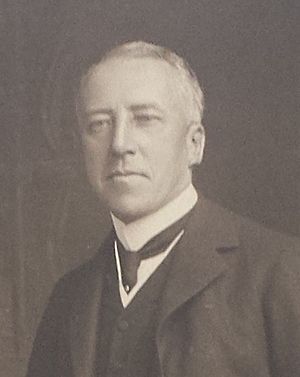William Arthur Dring facts for kids
Quick facts for kids
William Arthur Dring
|
|
|---|---|

Sir William Arthur Dring in about 1905
|
|
| Born | 9 November 1859 |
| Died | 24 November 1912 Gujhandi, British India
|
Sir William Arthur Dring (born November 9, 1859 – died November 24, 1912) was a very important person in the history of railways in India. He was the General Manager of the East Indian Railway Company from 1907 until he died in 1912. He helped the railway system in India grow a lot. A large monument marks the place where he died. He was also the father of John Dring, who later became the Prime Minister of the independent State of Bahawalpur (which is now part of Pakistan).
Contents
Early Life and Education
William Arthur Dring was born in Halifax, Nova Scotia, in what was then British North America. This was on November 9, 1859. His father was a soldier stationed there.
In 1865, when William was six years old, his family moved to India. The Dring family had lived in India for a long time, since 1830. They stayed connected to the country for many generations.
William went to school at Taunton's College in Southampton, England.
Building India's Railways
In 1879, William Dring started working for the East Indian Railway Company. He began as an Assistant Secretary to the General Manager, Sir Bradford Leslie. Leslie was a famous engineer who built important bridges.
Leslie quickly saw that Dring was very talented and good at organizing things. He moved Dring to the traffic department. Here, Dring became an expert in how trains and goods moved around.
Becoming a Traffic Manager
In 1896, Dring was promoted to General Traffic Manager of the East Indian Railway Company. He held this important job for more than ten years. He was known for finding clever ways to solve problems with transport.
One famous example happened in January 1903. A huge event called a Durbar was planned in Delhi. It was to celebrate King Edward VII becoming King-Emperor of India. More than 12,000 people needed to travel from Bengal to Delhi in just a few days.
Normally, only about 400 first and second-class passengers made this trip in a whole month. It seemed impossible to move so many people. Dring came up with a brilliant idea. He took parts meant for lower-class train cars and turned them into temporary sleeping carriages for the higher-class passengers. This solution saved the day and made the Durbar possible.
Leading the Railway Company
In 1907, Dring became the Agent, or General Manager, of the East Indian Railway Company. He was the first person from the traffic department to reach this high position.
Under Dring's leadership, the railway company grew a lot. The railway lines expanded from 1,887 miles to 2,600 miles. More passengers and goods were transported, and the railway became much more efficient.
Because of his great work, Dring received special honors. He was made a Companion of the Order of the Indian Empire in 1909. Then, in 1911, King George V made him a Knight Commander of the Order of the Indian Empire. This meant he was given the title "Sir."
Dring was also a Lieutenant Colonel in the East Indian Railway Volunteer Rifles. He was an Honorary Aide-de-camp to the Commander-in-Chief in India. He was also the president of two important clubs in Calcutta: The Saturday Club and the Bengal Club.
Family Life
William Dring married Jane Reid Greenshields Alston on January 18, 1899. They had two children. Their daughter, Helen Marian Dring (born 1899), received an award for her help during the evacuation of Burma in 1942.
Their son, John Dring (born 1902), became the second Prime Minister of the independent State of Bahawalpur. This state is now part of modern Pakistan.
Mysterious Death
After receiving his knighthood in 1912, Dring went to England for a six-month holiday. He returned to India by ship on November 22. As the General Manager of the railway, Dring had his own special train car. This car had a bedroom, dining room, office, and kitchen. It also had an observation platform at the very back.
On the morning of November 24, 1912, Dring's train arrived at a station called Gujhandi. The train was running a bit late. Dring told the Station Master to send a message ahead to make sure there was enough water for the engine at the next station. This was the last time anyone saw Dring alive.
Later, Dring's servant went into his train car. Dring was not there, but his slippers were on the observation platform. About two kilometers from Gujhandi, a railway worker saw a man standing between two moving train cars. The man seemed to be in trouble. A little further on, other railway workers saw what looked like a pile of white rope on the tracks. When one of them checked, they found Dring's body. He was lying face down with a serious head injury.
How Dring fell from the train remains a mystery. A friend said that Dring often drank his morning tea while sitting on the railing of the observation platform. Perhaps a sudden jolt of the train caused him to fall. No one has ever fully explained how such an experienced person could have fallen during his daily routine.
Dring's death was a great shock to everyone in Calcutta. He was very well-known and liked by both Indian and European people. He had a very large military funeral. A newspaper called it "The biggest and most impressive" funeral seen in Calcutta for many years. The Indian railway staff even collected money to build a huge monument where Dring died. This monument still stands there today.
Images for kids


